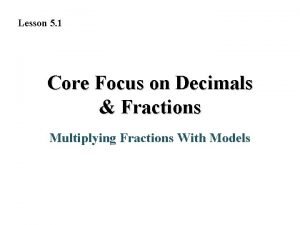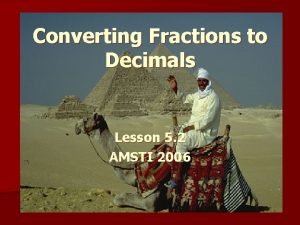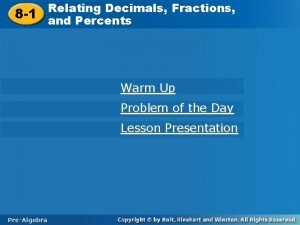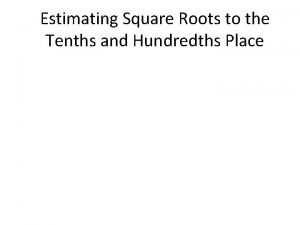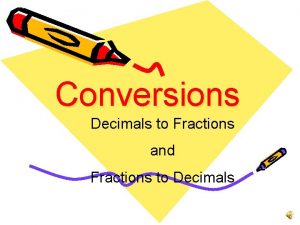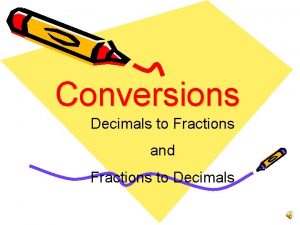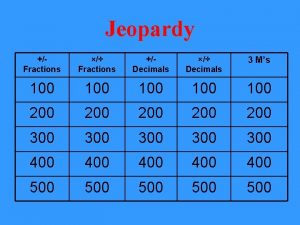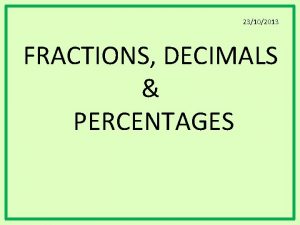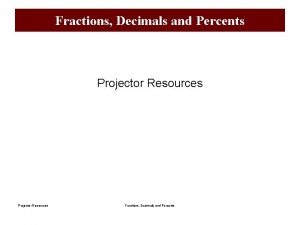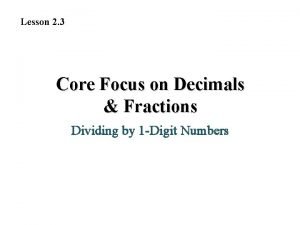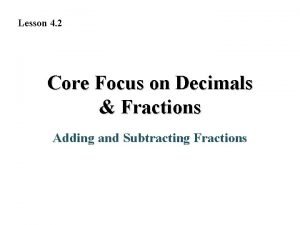Lesson 5 1 Core Focus on Decimals Fractions













- Slides: 13

Lesson 5. 1 Core Focus on Decimals & Fractions Multiplying Fractions With Models

Warm-Up 1. 6 × 7 42 2. 9 × 9 81 3. 8 × 3 24

Lesson 5. 1 Multiplying Fractions with Models Use models to multiply fractions.

Explore! Find the value of following steps. Fraction Action (which is read ) by completing the Step 1 Divide a piece of paper horizontally into as many sections as are shown in the denominator of one of the factors. For , divide the paper into 4 horizontal sections. Step 2 Use blue to color in as many horizontal sections as are shown in the numerator. For , color in 3 of the 4 sections. Step 3 Divide the piece of paper vertically into as many sections as are shown in the denominator of the factor. For , divide the paper into 6 vertical sections.

Explore! Find the value of following steps. Step 4 Fraction Action (which is read ) by completing the Use yellow to color in as many vertical sections as are shown in the numerator. For , color in one of the vertical sections. Blue and yellow make green Step 5 The answer to your product is Simplify if necessary

Explore! Find the value of following steps. Fraction Action (which is read ) by completing the Step 6 Repeat Steps 1 -5 by finding the product of at least four different pairs of fractions from the purple box. Step 7 Does it matter which fraction in the equation is shaded first? Explain your reasoning.

Example 1 Rafael’s mom had cup of blueberries. She split the blueberries among her three children. Each received of the blueberries. What fraction of a cup of blueberries did each child receive? Write the problem. Draw a rectangle and divide it into fourths horizontally. Shade of the rectangle, or three of the four sections, with blue.

Example 1 Continued… Rafael’s mom had cup of blueberries. She split the blueberries among her three children. Each received of the blueberries. What fraction of a cup of blueberries did each child receive? Divide the rectangle vertically into thirds. Shade of the rectangle, or one of the vertical sections, with yellow. There are now 12 sections on the rectangle. This is the value of the denominator.

Example 1 Continued… Rafael’s mom had cup of blueberries. She split the blueberries among her three children. Each received of the blueberries. What fraction of a cup of blueberries did each child receive? There are 3 sections that were shaded twice. This is the value of the numerator. Simplify. Each child received cup of the blueberries.

Example 2 Find the value of using models. Draw a rectangle and divide it into thirds horizontally. Shade two of the three sections with blue. Divide the rectangle vertically into fifths. Shade four of the five vertical sections with yellow.

Example 2 Continued… Find the value of using models. There are 15 sections on the rectangle. This is the value of the denominator. There are 8 sections shaded twice. This is the value of the numerator. The fraction is in simplest form, so

Communication Prompt Why might knowing how to use models to multiply fractions be helpful to you?

Exit Problems 1. Draw a model to represent . Find the product. 2. Draw a model to represent . Find the product. 3. Write the equation to match the model. 4. Write the equation to match the model.
 Lesson 5 decimals and fractions
Lesson 5 decimals and fractions Two sevenths as a decimal
Two sevenths as a decimal Lesson 6-2 fractions, decimals, and percents answers
Lesson 6-2 fractions, decimals, and percents answers Converting fractions to decimals lesson
Converting fractions to decimals lesson Whats 45/100 in simplest form
Whats 45/100 in simplest form Relating decimals to fractions
Relating decimals to fractions Ordering fractions and decimals
Ordering fractions and decimals How to do multi step equations with fractions
How to do multi step equations with fractions How to multiply fractions with decimals
How to multiply fractions with decimals Hundredths square
Hundredths square Changing decimals to fractions and vice versa
Changing decimals to fractions and vice versa Compare and order fractions and decimals
Compare and order fractions and decimals Compare fractions and decimals
Compare fractions and decimals Recurring decimals gcse questions
Recurring decimals gcse questions
